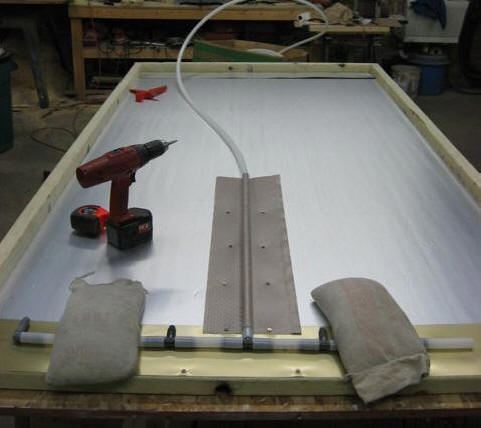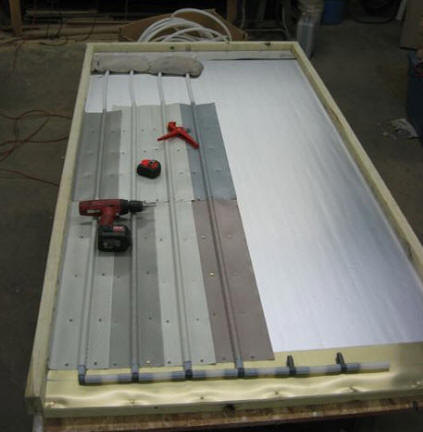
Search
The Renewable Energy site for Do-It-Yourselfers
Pool Collector
Using PEX Tubing and Aluminum Fins
This is Tom's design for a pool heating
collector that uses PEX tubing for the collector risers with pressed
aluminum fins.
The collector is very simple to make, and
the combination of PEX tubing and no glazing makes it a very inexpensive
collector to build. I believe that it will be a very
efficient pool heating collector -- at least as efficient as
commercial plastic collectors.
The collector is not glazed, so overheating
of the PEX should not be an issue, but the PEX should be protected from any
direct exposure to sunlight by either the aluminum fins, or, in areas not
covered by the fins, the PEX should be painted or covered.
Tom has worked out a very neat way to allow
the use of simple irrigation system T fittings to assemble the risers to the
manifold.
The larger manifold will allow several collectors to be hooked up end to end
without starving the last collector of flow. Be sure when hooking up collectors end to end to
run the supply and return to opposite corners of the collector array -- this
way the flow path length through each riser is the same.
Tom formed the grooves in the aluminum fins that fit closely over the PEX
with this press
that he made. For those of use with less machine shop skills,
this sledge
hammer method can be used -- its more work, but it works fine for a few
collectors.
Thanks very much to Tom for providing this
description and pictures of the pool collector!!
Update:
Tom has a
new website with additional info on his solar projects and products...
| |
Update from Tom after first full season of use -- October 2009:
Pool Solar collectors:
The system worked without a hitch all
summer long. The 8 panel array yielded about 160,000 BTU's per day,
which on a pool the size of the one I was working on amounted to
one degree a day. Unfortunately, we had one of the coldest summers
on record, and the cold nights robbed heat faster than we could
generate it. Overall, the pool owner (a friend) was happy with the
system and noticed every sunny day he was gaining heat. About the
only drawback is the "unglazed collectors" collected pine needles
from nearby pine trees. The system was drained and prepped for
winter last week.
|
Tom's Description
I've designed an unglazed swimming pool
collector, pretty much the same design
as yours, but keeping everything as cheap
as possible. I'm using 4' x 8' x 1/2" treated plywood for the back, a border of
treated lumber that recesses the "edge" of the plywood for weather protection,
and 1/2" polyisocyanurate under the absorber. I like the insulation on top of
the board for two reasons. No thermal loss between the absorber/hose area and
the wood, and the exposed back is a durable material (the plywood). I like the
manifold design for drainback, and it works nicely for a "modular" panel (each
4' x 8' panel is a separate module). With this concept, I can add or subtract
modules based on the pool size.
|
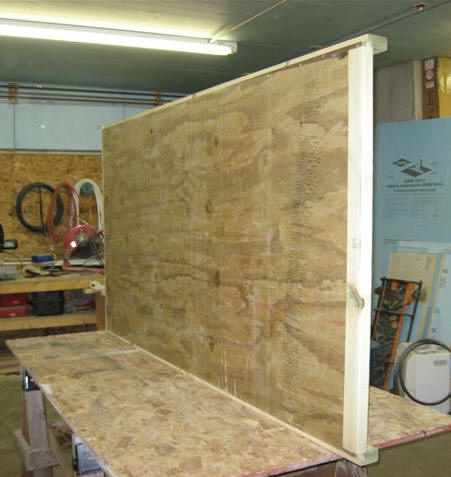
Treated plywood backer board with edge
edging to protect the plywood edges from the weather.
|
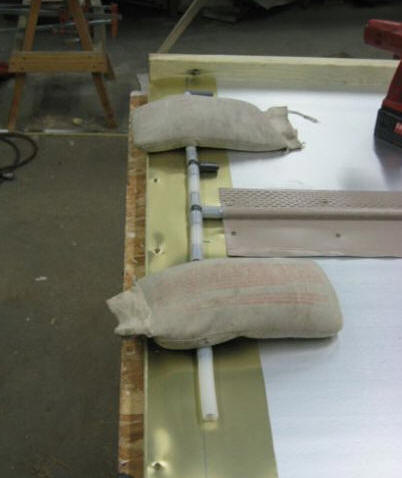
Note the press together irrigation fittings used
to connect the manifold and risers.
|
|
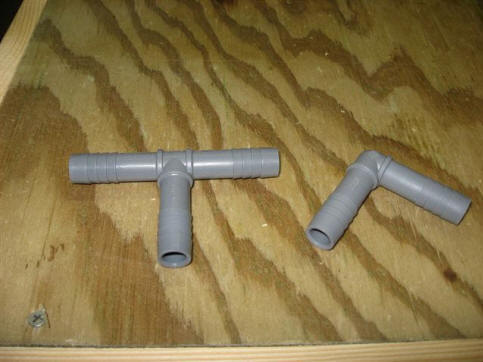
Close-up of the injection molded irrigation fittings.
|
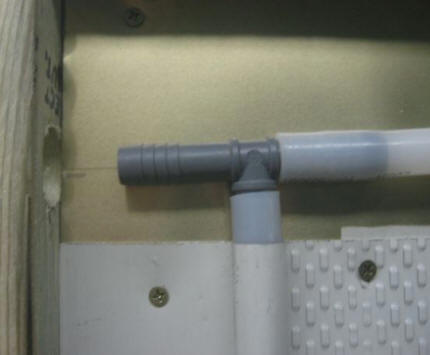
5/8ths PEX tubing heated up a bit and pushed
into place on the fitting -- no clamp required. |
The "T"s I am using for my
connections are a "Lasco" irrigation fitting, actually a 1/2" injection molded
plastic fitting which works great with 5/8" PEX. I just heat the end of the PEX
for 15 seconds with a heat gun and push the softened PEX onto the fitting. It
grips the PEX so well no clamps are required. I found another source for the
fittings (at a local plumbing distributor) that's cheaper than the Lasco ones
I've been getting at Home Depot. Apparently there are several vendors making the
black irrigation hose and fittings.
The plastic (injection molded)
irrigation "T"s are 1/2" all three directions. For my last order on those, I
got the cost down to $.33 a piece. I'm using 5/8" PEX for both the manifolds
and the risers. I had about 800'-900' of the 5/8" PEX left over from another
project. I would have liked larger manifolds, but everything was working out so
cheap I thought I would give this design a try.
The websites for the cheaper "T"s and
the Lasco fittings are listed below. Either the Lasco or "Seal Well Products"
will work. It just depends on where you can find your best pricing in you local
area. Home Depot stocks the Lasco product, and the "T"s ran about $.62 a piece
there. The Boshart, known as B.I.I. product (Seal Well) show list pricing on
their web site. I purchased these for $.33 each locally, so the list pricing is
quite a bit higher than you will pay if you can find them at a plumbing
"wholesale" store.
http://www.boshart.com
http://www.lascofittings.com/
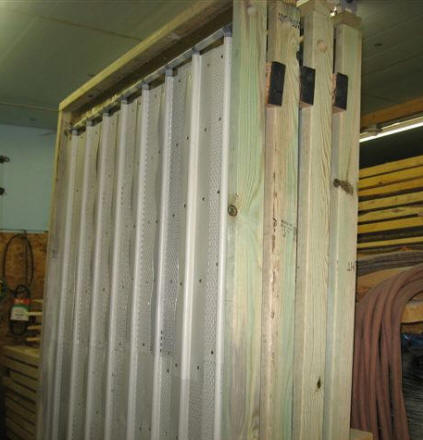
Four completed collectors
I think the PEX will work good for the pool
collector. The absence of glazing should eliminate much possibility of over
heating it. I plan to design an on/off switch for the array, and then add an
over-ride control that turns the pump on if the absorbers hit 200 degrees. You
can always run the array at night or leave the pool cover off if the water is
actually getting too warm (don't think that's going to be a problem up here).
Collector Cost
| |
| |
Solar Pool Heater Costs |
|
|
|
| |
|
|
|
|
|
|
|
| |
|
Option 1 |
|
|
Option 2 |
|
|
|
Material |
Unit Price |
Quantity |
Cost |
|
Quantity |
Cost |
|
| |
|
|
|
|
|
|
|
|
3/4" OSB |
10.78 |
1 |
10.78 |
|
|
0 |
|
|
1/2" Treated |
26.95 |
|
0 |
|
1 |
26.95 |
|
|
1/2" Poly Insulation |
11 |
1 |
11 |
|
1 |
11 |
|
| |
|
|
|
|
|
|
|
|
2"x4"x8' Treated |
3.1 |
2 |
6.2 |
|
2 |
6.2 |
|
|
!/2" Barbed "T" Fittings |
0.42 |
16 |
6.72 |
|
16 |
6.72 |
|
|
1/2" PEX |
0.43 |
66 |
28.38 |
|
66 |
28.38 |
|
| |
|
|
|
|
|
|
|
|
.018" x 8" Aluminum |
0.42 |
60 |
25.2 |
|
60 |
25.2 |
|
| |
|
|
|
|
|
|
|
|
Screws |
|
|
5 |
|
|
5 |
|
|
Paint |
|
|
10 |
|
|
10 |
|
|
MI Sales Tax |
|
|
6.38 |
|
|
7.35 |
|
|
Labor |
6.5 |
0 |
0 |
|
0 |
0 |
|
|
Total |
|
|
109.66 |
|
|
126.8 |
|
| |
|
|
|
|
|
|
|
|
Optional Material costs |
|
|
|
|
|
|
|
|
5/4" x 12' Plastic Decking |
24.95 |
1 |
24.95 |
|
|
|
|
|
2"x6"x8' Treated |
5.95 |
1.5 |
8.925 |
|
|
|
|
|
18" x 12' Alum Soffet |
15 |
2.5 |
37.5 |
|
|
|
|
|
|
|
|
|
|
|
|
|
|
|
Tom
Tom will answer email questions --
you can reach him at: toms1 AT chartermi DOT net (replace At with @, DOT with
.)
Tom's Other Projects
Tom has sent in several great
renewable energy projects ...
I'd offer one small alternative to
Tom's design to think about.
The alternative would be to leave the
insulation board out and apply the aluminum fin directly to the plywood.
The thinking behind this is that 1) for most pool collecting applications, the
pool water will be cooler or nearly as cool as the ambient air, and when this is
the case, the insulation is not really needed because there is no heat loss, and
2) by having the fin in direct contact with the plywood, it will be easier to
staple it down so that it fits very tightly against the PEX riser tubes -- this
is important to get good heat transfer from the fin to the riser tube.
Part 2 is not so much of an issue for
Tom, in that his press forms a very good fin groove that snaps on the tube, but
it is more of an issue for fins formed with
this sledge
hammer method .
Along the same line, I would use a bead of silicone in the groove before
stapling it down -- the silicone fills any tiny air gaps that might remain
between the aluminum and the PEX. The silicone is 10 times more
conductive than the air it replaces, but any remaining silicone filled gaps must
still be very very thin for good heat transfer.
Gary March 31, 2009





